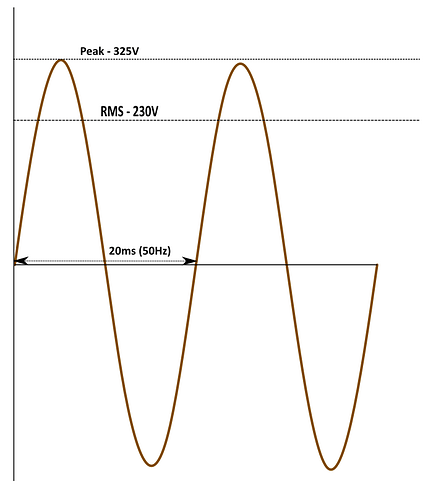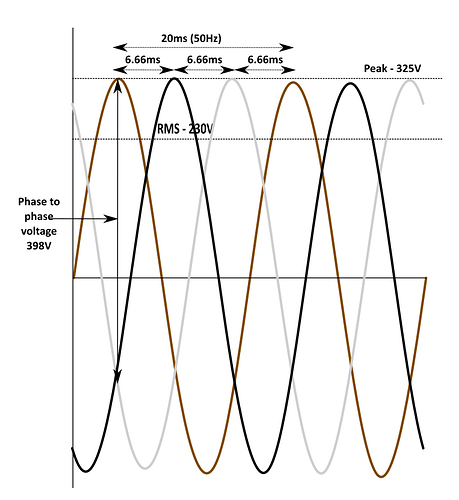No, as Jonathan says
Yes.
I’m not quite sure of the easiest way to explain three phase supplies (a sign I don’t understand it thoroughly myself) - and apologies if this is not needed, but I suspect 3-phase is poorly understood.
In a single phase AC supply the live voltage swings above and below the neutral line like so:
The RMS voltage - what we think of as “mains voltage” is lower than the peak of the voltage swing, it’s actually the voltage that would dissipate the same power into a resistive load were the voltage DC.
The time between each peak in the voltage waveform is 20ms which means 50 complete cycles fit in 1 second so the frequency is 50 cycles per second or 50Hz - this is actually tied to the speed at which the generators spin.
When you have a 3-phase supply, you do not just get three copies of the above. The peak voltage in each phase happens at a slightly different time, this is because each phase is generated from a separate winding on the generator rotor, offset by 120 degrees from each other - we say the phases are 120° apart.
Why do this - well, one reason is that it makes distribution networks more efficient. If you just had single phase all the way from the generator to the load it would work but you’d need to run live and neutral cables all the way - the live is OK, it’s delivering power to the load, but the neutral - that’s not doing much that is useful except completing the circuit. But it takes just as much copper as the live.
So, notice that in a three phase system we can draw power between phases. The voltage between phases is actually higher than that between phase and neutral which is handy - it’s about 400V for a 230V nominal supply and 415V for a 240V nominal supply. That’s why all the three phase cabinets in the UK say “Danger 415V” even though the supply is only 240V.
If we draw roughly equal power from each phase all the current flows between the phases and none flows in the neutral - so we don’t actually need a neutral. In practice a smaller neutral is provided - if you look at a pylon you will notice the three phases fairly easily but if you look carefully there is normally a much lighter cable running at the top of the pylon - that’s the neutral.
So, 3-phase is more dangerous than single phase because the phase to phase voltage is much higher (it’s actually 1.73 times higher) than the phase-neutral voltage and generally you want the load to be balanced between phases to prevent too much current flowing in the neutral - if you get it badly wrong you can get a voltage drop in the neutral which raises it above earth, however this voltage will not be in phase with all of the live conductors and in the same way that phase-phase voltages are higher than phase-neutral (or earth) voltages you can wind up with phase to neutral voltages which are much higher than they should be, which can damage equipment.
Anyway the TL;DR point is that three phases is baked into the system right from the generator and you can’t have two out of the three as you need to balance the load out between phases. Single phase distribution typically has the houses going L1, L2, L3, L1,… down the street to produce a balanced load.
In some countries - e.g the US where they chose too low a voltage for high power appliances (but good for safety) the option exists to have a “split phase” supply - in this case the two phases are generated at the transformer and are 180° apart - i.e the peak of the waveform in one phase corresponds to the trough in the other and the phase to phase voltage is twice the monophase voltage. This then gives a 240V supply for higher power appliances (like tumble dryers or air conditioning).

